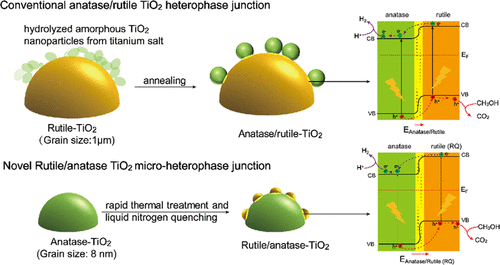当前位置:
X-MOL 学术
›
ACS Appl. Energy Mater.
›
论文详情
Our official English website, www.x-mol.net, welcomes your
feedback! (Note: you will need to create a separate account there.)
Construction of the Rutile/Anatase Micro-Heterophase Junction Photocatalyst from Anatase by Liquid Nitrogen Quenching Method
ACS Applied Energy Materials ( IF 5.4 ) Pub Date : 2021-09-03 , DOI: 10.1021/acsaem.1c02066 Chengwei Qiu 1 , Jinni Shen 1 , Jinjin Lin 1 , Dan liu 1 , Dongmiao Li 1 , Jiangjie Zhang 1 , Zizhong Zhang 1 , Huaxiang Lin 1 , Xuxu Wang 1 , Xianzhi Fu 1
ACS Applied Energy Materials ( IF 5.4 ) Pub Date : 2021-09-03 , DOI: 10.1021/acsaem.1c02066 Chengwei Qiu 1 , Jinni Shen 1 , Jinjin Lin 1 , Dan liu 1 , Dongmiao Li 1 , Jiangjie Zhang 1 , Zizhong Zhang 1 , Huaxiang Lin 1 , Xuxu Wang 1 , Xianzhi Fu 1
Affiliation

|
Heterophase junction composite semiconductors have been documented to exhibit better photocatalytic activity than the corresponding single-phase semiconductors for chemical reactions such as the hydrogen evolution and the degradation of pollutants. However, how to further improve the photocatalytic activity of these materials is a great challenge from the perspective of theory and practice. Herein, we report the synthesis of the rutile/anatase micro-heterophase junction from nanoscale anatase TiO2 by a rapid thermal treatment followed by liquid nitrogen quenching (RQ). The RQ micro-heterophase junction sample showed excellent photocatalytic hydrogen evolution activity, which has 4–5 times higher hydrogen production rate than that of nude anatase and P25-TiO2, and 2 times better hydrogen production rate than the anatase/rutile TiO2 heterophase sample with comparable Brunauer–Emmett–Teller (BET) surface area and phase composition obtained through slow thermal treatment and natural cooling (SN) process. The enhanced photocatalytic capacity of the RQ sample is attributed to the formation of a rutile/anatase micro-heterophase junction and its modification of the heterophase interface in the treatment process. Especially, the RQ-TiO2 sample shows a stronger electron paramagnetic resonance (EPR) signal of Ti3+ than the pristine anatase, rutile TiO2, and SN-TiO2, implying the formation of Ti3+ ions at the interface between anatase and rutile components. This results in moving down the Fermi level of the rutile phase by 330 meV. This increases the Fermi level difference between anatase and rutile, increases the build-in electric field (BIEF) of the anatase/rutile heterophase junction, and the separation as well as the transfer of photogenerated charge carriers more effective through the rutile/anatase heterophase interface. This work provides not only a facile method for the preparation of the rutile/anatase micro-heterophase junction from anatase but also finds a pathway to regulate the BIEF with a self-doped low-valence metal ion.
中文翻译:

液氮淬火法构建锐钛矿型金红石/锐钛矿微异相结光催化剂
已证明异相结复合半导体在化学反应(如析氢和污染物降解)中表现出比相应的单相半导体更好的光催化活性。然而,如何进一步提高这些材料的光催化活性,从理论和实践的角度来看都是一个巨大的挑战。在此,我们报告了通过快速热处理和液氮淬火 (RQ)从纳米级锐钛矿 TiO 2合成金红石/锐钛矿微异相结。RQ微异相结样品表现出优异的光催化析氢活性,其产氢速率比裸锐钛矿和P25-TiO 2高4-5倍,并且比锐钛矿/金红石型 TiO 2异相样品的产氢率高 2 倍,具有可比的 Brunauer-Emmett-Teller (BET) 表面积和通过缓慢热处理和自然冷却 (SN) 工艺获得的相组成。RQ 样品增强的光催化能力归因于金红石/锐钛矿微异相结的形成及其在处理过程中对异相界面的修饰。特别是,RQ-TiO 2样品显示出比原始锐钛矿、金红石 TiO 2和 SN-TiO 2更强的 Ti 3+电子顺磁共振(EPR)信号,这意味着 Ti 3+的形成锐钛矿和金红石成分界面处的离子。这导致金红石相的费米能级下降 330 meV。这增加了锐钛矿和金红石之间的费米能级差,增加了锐钛矿/金红石异相结的内建电场 (BIEF),以及通过金红石/锐钛矿异相界面更有效地分离和转移光生电荷载流子. 这项工作不仅为从锐钛矿制备金红石/锐钛矿微异相结提供了一种简便的方法,而且还找到了用自掺杂低价金属离子调节 BIEF 的途径。
更新日期:2021-09-27
中文翻译:

液氮淬火法构建锐钛矿型金红石/锐钛矿微异相结光催化剂
已证明异相结复合半导体在化学反应(如析氢和污染物降解)中表现出比相应的单相半导体更好的光催化活性。然而,如何进一步提高这些材料的光催化活性,从理论和实践的角度来看都是一个巨大的挑战。在此,我们报告了通过快速热处理和液氮淬火 (RQ)从纳米级锐钛矿 TiO 2合成金红石/锐钛矿微异相结。RQ微异相结样品表现出优异的光催化析氢活性,其产氢速率比裸锐钛矿和P25-TiO 2高4-5倍,并且比锐钛矿/金红石型 TiO 2异相样品的产氢率高 2 倍,具有可比的 Brunauer-Emmett-Teller (BET) 表面积和通过缓慢热处理和自然冷却 (SN) 工艺获得的相组成。RQ 样品增强的光催化能力归因于金红石/锐钛矿微异相结的形成及其在处理过程中对异相界面的修饰。特别是,RQ-TiO 2样品显示出比原始锐钛矿、金红石 TiO 2和 SN-TiO 2更强的 Ti 3+电子顺磁共振(EPR)信号,这意味着 Ti 3+的形成锐钛矿和金红石成分界面处的离子。这导致金红石相的费米能级下降 330 meV。这增加了锐钛矿和金红石之间的费米能级差,增加了锐钛矿/金红石异相结的内建电场 (BIEF),以及通过金红石/锐钛矿异相界面更有效地分离和转移光生电荷载流子. 这项工作不仅为从锐钛矿制备金红石/锐钛矿微异相结提供了一种简便的方法,而且还找到了用自掺杂低价金属离子调节 BIEF 的途径。

































 京公网安备 11010802027423号
京公网安备 11010802027423号